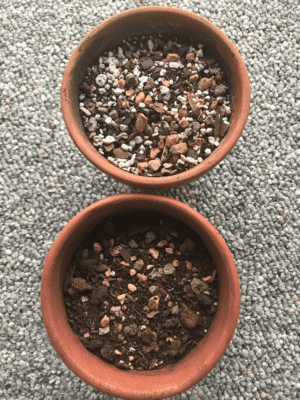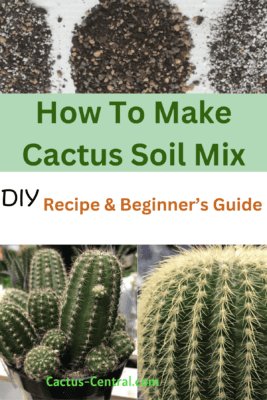This post contains affiliate links.
Most potted cactus plants will eventually outgrow their container and will need to be replanted into a new larger one. When that time comes, what kind of soil mix should you use?
You should use a good quality cactus soil mix. And you can control the quality of the soil mix by making your own by following a good recipe.
You can make a cactus soil mix by mixing together inorganic materials such as grit, pumice, coarse sand, perlite, and more with some organic materials such as coconut coir, peat, or potting soil. The final soil mix should be one that is porous, resists compaction, and drains quickly.

Cactus plants need soil that drains quickly and is well aerated; your soil mix should be one that has the right balance of both inorganic and organic materials. You don’t want too many organic materials in the mix as it could cause problems for your cactus plants – but you do need some in the right proportions. Some pre-made mixes have too many organic materials added, so the best way to know you have the right balance is to make your own cactus soil using a good basic recipe.
Cactus Soil Mix Recipes and Why the Differences?
A good cactus soil mix contains both organic materials and inorganic materials mixed together in the right proportions such that the final soil mix is of the correct texture where the soil is well-aerated, drains quickly after being watered, and resists being compacted.
If you search around, you will find that not all recipes have exactly the same ratio of materials or even use the same kinds of organic or inorganic materials. Many are the same or very similar, but there are some differences.
Many of those differences can be due to what type of organic or inorganic materials are being used and even what others have found to work well for them through experience. All of them are trying to get that perfect “ratio” of organic to inorganic materials needed in a good cactus soil mix.
For your reference, these ratios were found in the following source.
What Are The Ratios We’re Using in Our Recipes?
We have two basic ratios that we are using in our recipes: One is for desert cacti and another is for tropical cacti.
They are based on a ratio of:
2:1, inorganic to organic materials for desert cacti
and a ratio of:
1:1:1, inorganic, potting soil, peat moss for tropical cacti.
The specific recommended organic and inorganic materials for each recipe are listed in more detail further below.
Supplies Needed:
You will need a few supplies to help you in making your soil.
🌵Coarse Sand or Grit/gravel. Check out this coarse sand on Amazon. Coarse sand like this is the type of sand you should use in your cactus mix.
🌵Perlite Amazon has this one by Harris – check it out if you’re interested.
🌵Pumice
🌵Potting soil
🌵Peat moss (for the Tropical cactus recipe only) It is probably best that you buy this locally since they are usually sold in heavy (and bulky) blocks.
🌵Container to mix and store the soil.
You will need a container to mix and hold your cactus soil. This can be anything you have on hand.
I prefer to use a wheelbarrow if I’m making up larger quantities of soil but I also use 5-gallon buckets (or a similar type of container) – with a lid.
This is especially convenient for me since I can use the buckets to protect and store my soil mix and I can also stack it in my storage area. (This helps a lot when storage space is limited.)
You can find these buckets at many local stores such as Walmart, but if you want to look online at Amazon, this 5-gallon bucket would work very well for mixing and storing your cactus soil.
🌵Gloves and hand trowel. Amazon has these gloves and hand trowel if you don’t have any and need some.
Soil Mix Recipe For Desert Cacti

- 1 part coarse sand/grit/ gravel
- You can use a combination of these as long as you still keep the required 1 part.
- 1 part perlite or pumice
- You also can use a combination of these, just keep it to the required 1 part.
- 1 part peat-based potting soil
- The potting soil is the part that contains the organic materials in this recipe and you do not want to make substitutions to this because you want to keep the correct organic to inorganic ratio. When choosing your potting soil, buy a brand that is light and fluffy (peat based) and not one that is heavy.
Once you have mixed all your ingredients together, make sure that the final mix will pass the “squeeze test.” Simply squeeze the mixture and see if it falls apart when you let go. If it clumps together then you have too many organic materials in the mix. If this happens, you will need to add some more inorganic materials to the mix.
Note: It’s nice to know that you can make substitutions, for example using sand in place of grit, because sometimes you may not have all the materials on hand. This also gives you the flexibility to make changes to the mix to best suit your needs or budget– or availability.
Soil Mix Recipe For Tropical Cacti

Tropical cacti generally do better with more organic materials in their soil, so the recipe here is slightly different than what was given for desert cacti.
- 1 part coarse sand, or grit — This is the inorganic material
- 1 part regular potting soil — This counts as the organic material since it is a peat-based potting soil.
- 1 part peat moss – This is an organic material.
There are other soil mix recipes for both desert cacti and tropical cacti that don’t use potting soil as an ingredient but use other individual organic ingredients like coconut coir– I plan to add some of these recipes in a future post.
What Are The Organic Materials Commonly Used For Cactus Soil?
There are a lot of organic materials that are often used when making cactus soil, such as:
- Peat Moss,
- Coconut coir (The fiber from the outer husk of a coconut)
- Peat moss-based potting soil
Having too much organic material in your soil mix is not good since it will make it hold onto moisture for too long, increasing the chance that your cactus will develop root rot. That is why you shouldn’t plant your cacti in regular potting soil alone since this type of soil is purposely made to hold onto water. It is formulated for other types of houseplants, but not cacti.
There does need to be some organic material in your cactus soil because it is where the plant gets some of its nutrients. If used in smaller amounts, regular potting soil can still be used if you mix it with some inorganic materials in the correct proportions. The same goes for peat moss and coconut coir and other organic materials.
Note: Some commercially available cactus soil blends, particularly those purchased at big box stores, include far too many organic materials in their formulation. This can be a cause for concern. Our other article here can help show you what to look for in a good quality soil mix.
But the good news is that there are some good quality commercially made mixes for sale and if you only have a few cacti, or want the convenience of ready-made soil, this might be the best choice for you.
If you have several cacti that you need to repot, it could be less expensive, overall, to make your own cactus soil mix, or if you have succulents you could instead follow this guide for making succulent soil mix.
What Are The Inorganic Materials Commonly Used For Cactus Soil?
There are many different inorganic materials that are often used for making cactus soil such as:
- Grit
- Gravel
- Coarse sand
- Pumice
- Perlite
Inorganic materials such as grit, gravel, and sand don’t readily break down. They break up the texture of the soil, preventing compaction.
Perlite or pumice are also inorganic materials and they don’t readily break down either but will disintegrate somewhat over time (long time) They are brittle and easily crushed. These inorganic materials increase the aeration and porosity of the soil.
Final Thoughts
If you gather the supplies together ahead of time to make your own cactus soil (using these recipes) you will be ready for when you need to repot your plants. It can save you from having to make a trip to town to buy cactus soil –when you’d rather be gardening, instead.
This post was written for cactus-central.com and is not permitted to be used on other sites.


